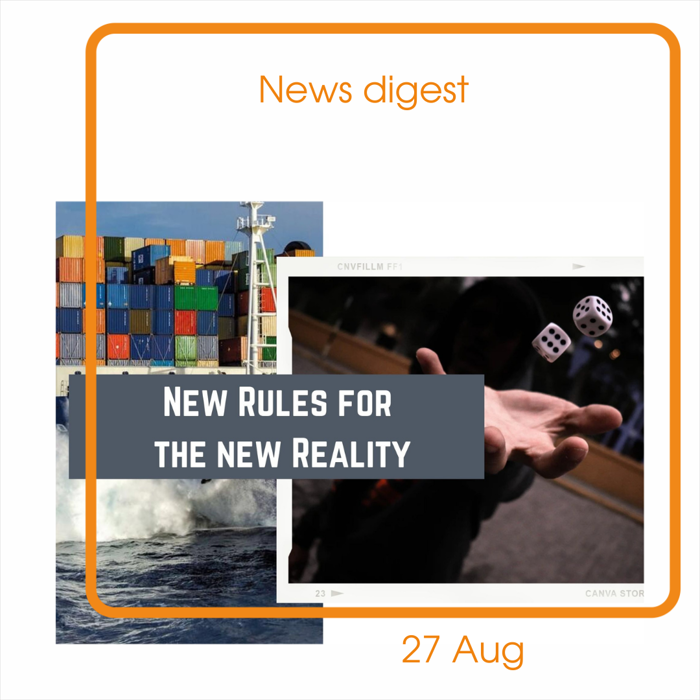News digest. 27 Aug
The big players have already emptied everything they could down to the smallest feeders, and now they are extending charter deals. Do the new rules even leave others a slight chance to survive?
The COVID-caused closure of Ningbo-Zhoushan port is slowly easing up as operations are expected to resume by the end of August. It has been observed that this congestion was the worst in the last seven years at the port. However, despite the improvements, it has triggered an already tight equipment shortage. It is likely that container prices will rise on lower availability in the coming weeks depending on whether the industry sees a further spike in container prices at Ningbo, how much cargo was disrupted at the port, and if there are additional shutdowns later.
Maersk backs the premise that the shutdowns in China and Vietnam will continue to bring chaos in the supply chain and over-the-roof container demand is destined to rise. The increase in the US alone is expected between 2-4% year-on-year for 2H 2021 and reflects in the 18.7% rise in global container trade in 2Q 2021 among major destinations. Did not a similar dynamic occur after Yantian? Back in the day, the lockdown resulted in a 180% spike in the price of containers; all box sizes sourced from Yantian, surged from $5,515 in June, to $15,336 in August.
On a charter market, ocean carriers are on a mission to charter new vessels. Cosco has joined others in trying to turn the heads of shipowners with substantial daily hire offers for 36-month periods. The updates state that this fixing spree follows a wave in June, which saw Cosco fixing and extending six classic panamaxes for periods of 36 months in the low $40,000 a day level. Experts have mixed feelings about the charter market dynamic – big carriers have taken everything off including the smallest feeders, so others are having troubles covering commitments with their clients. It is especially challenging now when owners are asking them to agree to new long-term extended charter deals at vastly inflated hire rates.
On the railway arena, the tension between China and Lithuania continues to draw the attention of the experts. Although China has contradicted the news that it would suspend rail communication with Lithuania because of Lithuania’s cooperation with Taiwan, the New Silk Road is not only a crucial artery but also a diplomatic tool. A tool that works both ways – the potential suspension of railways would cost Lithuania billions of dollars and the blockage of an ideal transit point Western and Northern Europe would cut China off.
A major development of rail connections Afghanistan has been in the talks for quite a while as it could open up Central Asian markets for countries in the southeast of Asia, most notably India, but the situation is about to take a new turn because of the Taliban. It is traditionally friendlier towards Pakistan, a political rival of India, so its further strategy could be the end of the Chabahar port project. India is not the only country noticing this cloud. Iran too is concerned about the future of its rail connections with Afghanistan.
The changes in the UK customs (there will be new safety and security requirements surrounding exports) processes bring concerns among cargo owners and hauliers. Shippers will be required to supply exit summary declarations for further movements, like empties being moved under a transport contract to the EU, and consequently, they do not understand what exactly exit summary declarations are. The government is yet to clarify and adjust the new regulations to the drivers’ crises and other constraints.
Another strike is looming over this time involving HMM's union after the company’s management rejected its demands for a generous salary increment. Both sides are in the process of negotiations because everyone understands that in case of a strike, there will be disruptions that the company simply cannot afford.
Shanghai Pudong International continues to undergo major delays as it mounts the new COVID outbreaks. Since nobody knows how long the pressure will last, some freight forwarders are considering alternative export methods, including a combination of ferry and air service via South Korea, or container shipping and air service via Singapore or Dubai.
The question of sustainable future or at least how realistic it is definitely a subject to collaborate approach. In order to cut carbon emissions at major ports, greater collaboration among stakeholders is essential when it comes to investments. The biggest trend ports will see in the near future is the development of hydrogen supply chains, but there will also be other areas of investment, including waste-heat networks and digital efficiency development. One of the recent examples is the Port of Tallinn that is teaming up with partners to design the hub of the Baltic Sea green infrastructure in Estonia.
Focusing on its growth, Ocean Network Express and Universal Container Services have opened a container storage center at the Port of Hamburg. The facility is not the first product of their collaboration – before it was a similar one at the Port of Rotterdam.

